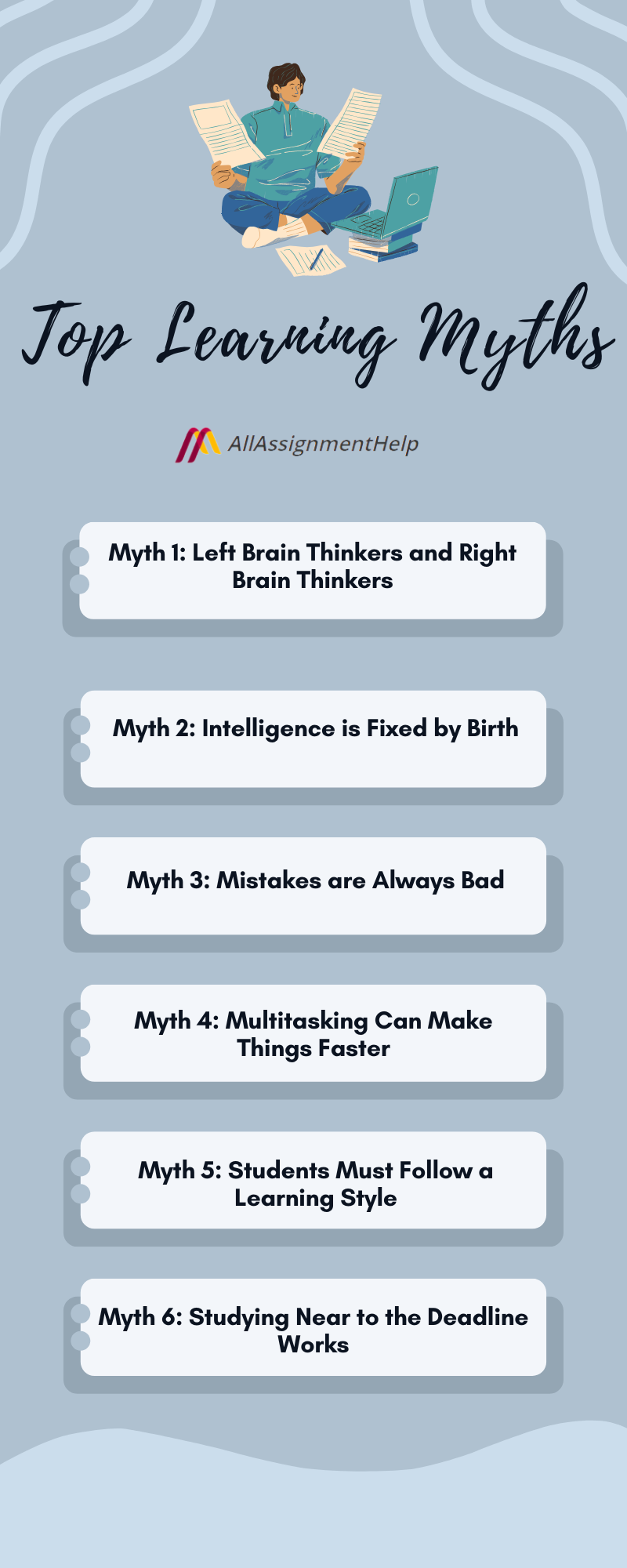Table of Contents
If you are someone who is learning, then you might have possibly heard about different learning myths. Different offline and online learning myths go around the corner, which makes students question the way they learn.
Have you ever questioned your learning styles? Or have you wondered if a change in your learning style will help you perform better? If you answered yes, that means you probably believe in learning myths. Learning is a complex but rewarding process. You must do both hard and smart work to get the best grades. There is no other shortcut to becoming Einstein overnight.
You might have heard many things about learning and how to be better at grades. But are you ready to debunk learning myths? The experts at All Assignment Help have specially curated this blog to dispel all the misconceptions. Refer to this blog to unlock all the offline and e-learning myths and find your learning potential.
Top Learning Myths
As a student, you might have heard and followed different learning myths. Here we have briefly listed the top learning myths believed by students and debunked these myths.

Myth 1: Left Brain Thinkers and Right Brain Thinkers
The left brain and right brain is one of the popular myths believed by students. Students believe that the left-brain thinkers are logical and great at analysis. They also think these students are likely good at logical subjects like English, mathematics, and chemistry.
On the other hand, right-brain thinkers are good at creativity, art, and imagination. They are said to be emotional and good at marketing, advertising, and designing. They also believe that the left-brain thinkers are systematic while the right-brain thinkers are spontaneous. This learning myth goes to the extent that students start questioning and forcing themselves to be good at those things. For example, as left-brain thinkers are analytical and logical, they should excel at logical subjects without seeking assignment help from anyone.
The truth is our brain functions as a whole. Both parts of the brain have similar work to do. The researchers and studies have concluded that our brains are identical on both sides with an integrated network of functions.
Techniques to Debunk this Myth
Are you someone who has believed this myth? Here are some evidence-based techniques to help you overcome this myth and be both logical and creative at the same time.
- You can also apply dual coding theory to combine verbal and visual information.
- To gain a deeper understanding of the topic, you can follow elaborative interrogation.
- The spaced revision method can also strengthen memory retention.
- Try interleaved practice when learning. It will train your brain to distinguish between concepts. It is one of the popular methods to help you perform on complex subjects like mathematics. Moreover, if you struggle to understand mathematics, hire experts for your online math class. Just search; I want to pay someone to do my online math class on the internet and receive the best help with your math classes.
Myth 2: Intelligence is Fixed by Birth
What is intelligence? Intelligence refers to an individual’s knowledge and ability to acquire new skills. According to psychologists, there are four types of intelligence: IQ, EQ, SQ, and AQ. Another common learning myth among students is that intelligence is often fixed by birth. Simply put, you will be intelligent if you are born with intelligence, which cannot be changed.
Fixed intelligence is a learning myth that can hinder students’ academic performance. Students who believe this myth often question themselves and doubt their intellectual capabilities. However, the truth is completely different. Several researchers worldwide have proved that IQ is subject to change according to the environment.
How is intelligence measured? Intelligence is difficult to define, but it can be measured through tests. A growth mindset, good coaching, and value from a teacher can change intelligence. One can debunk this learning myth by applying these evidence-based techniques.
- Always encourage growth mindset development. It has been found that students who follow a positive mindset are likely to perform more. For example, if you have failed or scored less in your online class, find a way to deal with these. You can adjust your study schedule to learn effectively. You may also hire online class takers by asking who can do my online course. The professionals who take your online class will help you overcome failure and achieve top grades in your class.
- Have you ever heard about neuroplasticity-based learning? It is an activity of engaging in challenging tasks. A 2004 neuroplasticity study has found that this technique can increase gray matter in relevant brain areas.
Myth 3: Mistakes are Always Bad
Are all mistakes bad? Have you ever tried to find the answer to this question? We often believe that mistakes are bad. Students often believe this learning myth and it affects their negligence or ability. To be honest, mistakes are not so bad. Rather, it is an opportunity to improve yourself.
Albert Einstein said that anyone who has never made a mistake has never tried anything new. Likewise, the students who make mistakes are likely to find out about their weak areas and explore more about new things. They can learn to rectify their errors timely and find a way to grow in their academics.
- Think of mistakes as a learning opportunity
- Find feedback on errors and make timely correction
- Experience productive failure to perform better
- Correct mistakes immediately to prevent misconceptions
- Making mistakes is not a crime, it is normal
- Reduce errors in the initial learning phase
- Reflect on your errors
The above-given are some of the evidence-based techniques to help you overcome learning myths about mistakes. Make sure to adapt these to correct mistakes and enhance your learning.
Also Read: Different Kinds Of Learning Styles- A Complete Guide
Myth 4: Multitasking is Best
Multitasking is something we all do irrespective of our age and work. Whether it is our mother in the kitchen or our father in their office, everyone thinks that multitasking will help them complete their work faster. Students also do multitasking, thinking it to be a productive way of learning.
Do you also try to multitask but end up seeking coursework help from online experts? We all have been there believing this myth and stressing ourselves. However, the actual fact is different. Our brain is not liable to do different things at one time. It can do one thing at a time. Whether it is studying, scrolling on the phone, or watching television. It cannot do multiple simultaneously.
Overloading your brain with many things at a time cannot do anything better for your learning. Debunk the learning myth of multitasking with these evidence-based techniques.
- If you are someone who is doing task reduction, stop it right away, as it can reduce your productivity.
- Use the time-blocking method, as it can prevent you from multitasking.
- As a student, you might have multiple assignments to do at a time. However, do not switch on different assignments at a time to complete things faster. First, complete one assignment and then start doing the other.
- Concentrate on a single task at a time. For example, if you have assignments and exams pending at the same time, try to focus on one thing at a time. Let’s suppose you are working on assignments and don’t have time for your exams; you can seek online exam help. Whenever you think, is there someone who can take my online exam for me? hire professionals with a three-step process. Professional online exam helpers can timely take all your online examinations on time with a guarantee of A grades.
Myth 5: Students Must Follow a Learning Style
Visual, auditory, reading or writing, and kinesthetic are the different learning styles followed by students. It is one of the popular learning myths that affect students’ ability to perform better in their academics. It is believed that every student has a learning style, and teachers should cater their teaching according to it.
There is no proof that you should always have a learning style. It is just a learning myth. Students can use different learning styles in their accounts to learn and read better. Students are free to use different activities to make their learning better. Let’s suppose you are learning a topic called the water cycle. This is a topic that has diagrams, verbal explanations, note-taking, and hands-on activities. One cannot learn this topic as a visual learner or auditory learner. Here you might need different techniques to learn the correct essence of the topic.
Whether you know your learning style or not, use these evidence-based strategies to enhance learning.
- Engage multimodal learning for a better study experience.
- Not just focus on gaining theoretical knowledge; try to gain practical knowledge and skills as well.
- Utilize active learning methods to reinforce learning faster.
- Use dual coding for better explanation and understanding.
Myth 6: Studying Near to the Deadline Works
Most students believe this learning myth and prefer to study near their schedules. Cramming will never work whether you are working on your assignments or preparing for your examinations.
If you think that you can complete your assignments in a day or cover your entire syllabus in a day, then it is highly impossible. No one can absorb information a day before the deadline. Students who study close to their deadline are likely to struggle more and perform less. It is just a learning myth and not a way to succeed in your academics.
Here are some of the tips to help students overcome their cramming habit.
- Use spaced repetition software
- Distribute study session
- Set achievable goals
- Reduce anxiety
- Use flashcards for better learning
- Take regular breaks or intervals between study sessions
Also Read: The Benefits of Personalized Learning in Modern Education
Conclusion
As a student, you might hear different learning myths. Some of the popular ones include online learning myths, language learning myths, and phonics learning myths. However, before believing in any myth, it is essential to understand the difference between learning myths vs. learning facts. In this blog, we have e-learning myths debunked.
In every part of your study life, whether in school or university, you might hear different things. Someone might claim to believe you with proof. However, you should understand that not all myths are true. Nothing can affect your learning process. It is an individual process that needs dedication and hard work. What works for your friends might not work for you, so never be sad about that. Never limit yourself or trust anything blindly. Experiment with different methods to find the best one for you and stop expecting overnight results. Work hard and achieve success.
Frequently Asked Questions
| Question 1: Are myths important in our learning? Myths in learning can solve many unanswered questions for students. It can make learning interesting and fun and leave a lasting impact on students. |
| Question 2: What are the biggest language learning myths? Fluency, great memory, and natural talent are important to learning a new language. Foreign languages can be learned through apps and books; these are some of the common language learning myths. |
| Question 3: What is the good way of learning? Studying properly, setting clear goals, trying spaced repetition, organizing notes, and taking breaks are some of the methods for effective learning. |
